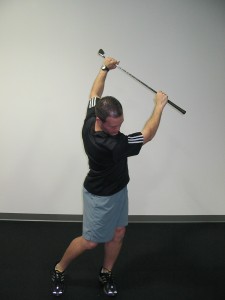Golf is in the air in Dublin, OH as Tiger and the PGA have invaded my neck of the woods for the Memorial Tournament. Too bad I am on vacation missing it!! Anyway, I just read a new research article validating what many of us have been saying for years about dynamic warm-up – this time it relates to golfers.
Do you care about club head speed, accuracy and consistent ball contact? Then listen up. In the most recent edition of the Journal of Strength and Conditioning Research, Jeffrey Gergley reveals some important findings relative to a passive stretching regime coupled with an active dynamic (AD) warm-up versus just an AD warm-up and its effects on golf performance.
In a nutshell, his study involved 15 young male competitive golfers. Immediately after the warm-up, each subject was instructed to hit 10 full-swing golf shots with their driver after their normal pre-shot routine with 1 minute rest intervals between each shot. The results are as follows:
Golfers who used the 20 minute passive stretch routine in addition to the AD warm-up with golf clubs saw:
- A 4.91% decrease in club head speed
- A 5.62% decrease in distance
- A 31.04% decrease in accuracy
- A 16.34% decrease in ball contact consistency
Wow!! The take home message is this – golfers should focus their warm-up routine on active movements with the golf club emphasizing the bio mechanical range of motion needed in the golf swing itself. Using a thorough dynamic warm-up will adequately prepare golfers to hit the ball better and reduce injuries.
Want such a warm-up? Check out my Healthy Golf Shoulders E-Book for such a warm-up at www.healthygolfshoulders.com. A sample warm-up move from it can be seen below.







